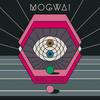Haim, a band of three sisters from Los Angeles, released their debut album Days Are Gone at the end of August this year, and with it came a critical response that felt both curious and a little overwhelmed. In an attempt to isolate the group to a few established sounds, some writers characterized them as mired indelicately in the '80s. As Greg Kot wrote in the Chicago Tribune, "Calling what they do “retro” doesn’t quite do it justice. It’s like the last two decades never happened." In his review for Pitchfork, Larry Fitzmaurice considered their geography of influences as considerably more expansive: "soft rock's incandescent glow, R&B's sensuality, the spiky-yet-polished effervescence of pop-rock." Of them all, Mike Powell came closest to conveying the expressive surface of the album, writing in SPIN that the record "sounds like something you might've heard on the radio in the mid or late 1980s—or, crucially, what you imagine you might've heard." There's little on the record that scans as pure pastiche; as with any music in which giant and familiar sounds are suddenly mingled in a way that feels effortless, determined, and identifiably young, the thrill of this record is in its implied dimensions, how these unwieldy units of past could be streamlined into something that seems to pitch suggestively forward.
Haim have often been compared to Fleetwood Mac, but they bring to mind a very specific embodiment of the band. 1987’s Tango in the Night, maybe the Mac’s most finely produced record, is so bright and glowing that even the lesser songs give off a kind of incandescence. Each instrument gently descends into view, but with a virtual depth and glimmer that lend them the qualities of tropical weather. Lindsey Buckingham never played his guitar so elusively again, particularly on “Everywhere” where it settles like percussion around John McVie’s bassline. It's as if Christine McVie’s keyboards get caught in the sweetness of its rotation.
This is how guitars function on Days Are Gone: like drums, but tuned, as if pulled through a kaleidoscope. “Drums were the first instrument that we played because my dad’s a drummer,” Alana Haim said in a phone interview back in July. “We grew up always being surrounded by percussion and drums and stuff like that, so it’s like the foundation of where we started.” A sense for percussion is also soaked into their voices; they sing with a kind of built-in turbulence. The notes are tightly cropped, isolated to individual words and sounds, feeling like brief stirs of the air.
There’s a long history of percussive singers (Michael Jackson; Van Morrison, though he is also a saxophone; Phil Lynott of Thin Lizzy; all hardcore singers are essentially an extra kick drum) and indeed sensing and inhabiting rhythm is elemental in the discipline of singing. The way the Haim sisters sing, though, first reminds me of Aaliyah, whose voice improbably navigated her producer Timbaland’s dense networks of rhythm. She worked against him as a varied counterpoint, as another drum, just as capable of complex, spidering migrations, deeply jointed as the neck of a deer.
Haim’s drum patterns aren’t nearly as tangled and overgrown, but they do resemble the rhythmic sensibilities of freestyle, a distinctly Latin dance music originated in the ‘80s, similar to electro but more sensitive and aerodynamic. The drums tended to pile up on themselves like ribbon. A few tracks into Days Are Gone, the central rhythm of “If I Could Change Your Mind” draws Danielle Haim’s guitar into itself, intricately knotting the two and causing it to sound like a stuttering descendent of Exposé’s “Come Go With Me” or Lisa Lisa & Cult Jam’s “Can You Feel The Beat.” All of its material is expressively woven into a kind of nervous system of percussion.
So many traditional indie rock bands seem to grow their songs from the guitar, all of the elements determined by the authority of a riff; with Haim, guitars seem additional, equal in magnitude to any minor flourish of drums or bass, creating rhythms that imply wholly reorganized worlds. “We were never like a strummy kind of band,” Alana said. “Strumming a guitar always sounded kind of cheesy to us. Not to say that strumming a guitar is cheesy; it can work, but it always sounded kind of weird in our tracks. So we always kind of used the guitars as a percussion instrument.” As a result it can be difficult to isolate a Haim sister to a particular instrument. They each play drums on the record, as well as a variety of other instruments, blending them into vivid compositions that move with the blur and glow of memory. Alana seemed sort of overwhelmed even trying to break down the record into discrete units of guitars or drums. “Everything’s very percussive and chopped up and playing a different kind of melody,” she said.
This could also account for the dizzying cloud of references that attaches to their music. Alana indicated that their style grew naturally and subconsciously from the musical environment in which she and her sisters grew up, specifically “the best pop/R&B late-’90s, early-2000s era, with Destiny’s Child, Aaliyah, Mariah Carey.” It would be rooted in their aesthetic no matter the final shape it took. “It’s really not a conscious thing where we’re like, ‘Oh yes, we really want to set out to mix rock and R&B’,” she said. “It’s more just, ‘This is what we want to hear on the radio. This is what we grew up wanting to hear and what we want to play’.”
Like Haim, The 1975, a young UK band who released their self-titled debut album in early September, deeply orient themselves around drums. Five songs into the record, on the song “Talk!”, drums and bass seem to pivot away from each other, creating an imbalance that feels like a deliberate refusal of gravity. By the time Matthew Healy’s vocals arrive, sounding shot out of a wormhole, the individual parts of the song are whirling inextricably together like a lightly angled cosmos. This, Healy suggests, is not only intentional but elemental to the process of the band. “I think that the defining elements of the way we think about things is drums and bass and the syncopation between those two things,” Healy said. “The idea of groove, for us, is so latent in our identity.”
Healy, who also plays guitar in the band, has often in interviews articulated his taste as a solid bedrock of ‘80s R&B: Whitney Houston, Michael Jackson, Prince, a sampling of artists that widely sketch an era when the advent of the drum machine allowed disco to reinfiltrate American pop. The rage listeners felt toward an identifiably queer and black music had either subsided or splintered irrevocably, sewing deeper into the music and into other dimensions of society. It didn’t read as disco, or even purely as funk or R&B; the grooves swam somewhere in the mist above the organized, almost gridlocked rhythms of the Roland TR-808 drum machine. Michael Jackson and Quincy Jones successfully produced this music until 1987; Jimmy Jam and Terry Lewis carried it well into the '90s. The 1975 expressively recreate it on “Settle Down,” the guitars caught up in an orbit that vividly recalls “Another Part of Me” from Bad. I can also hear it in Patrice Rushen's 1984 hit "Feels So Real"; the guitars sound as if they're being conducted by magnets, sweetly pulled through these gibbous phrases.
Of course many artists in the ‘80s applied this method of guitar playing; another sound I can isolate in The 1975’s music is that of Bryan Ferry's solo career, where he fashioned for himself a kind of seductively edgeless pop, music profoundly dedicated to its own aura. (This in itself is not entirely indifferent to R&B. In 1980, Ferry, just on the verge of solidifying this style, sang Wilson Pickett’s “In The Midnight Hour” on Roxy Music’s Flesh + Blood, but aside from the more sedimentary tones the a horn section, the instrumentation is weightless and fluorescent, as if largely dreamed.) Also, the desiccated pop of Scritti Politti, whose architect Green Gartside would eventually write "Love of a Lifetime" for Chaka Khan. In their more ambient, amniotic songs The 1975 also inhabit a space similar to The Blue Nile, a band so individual and glacial their songs can make one feel suspended in a timeless sphere.
As with Haim it’s difficult to tell if all of this is intentional or elemental, or if there’s even a necessary distinction between the two. It seems absolutely natural to weave one’s favorite things into art; it’s also possible that, on a long enough timeline (the Haim sisters were in a band with their parents when they were younger, and The 1975 have been technically together for 10 years, since each member was in high school), the assimilation of their tastes would become unconscious and irreducible. The 1975’s “Girls” is announced by an enormous riff, bright and twisting like moving crystal. When talking to me about it, Healy sounded as if he were retracing a process he hadn’t been around for. “We’ve never written a song to an agenda,” he said. “But if I imagine subconsciously what was going on at the moment, that was kind of a composite of ‘I Want You Back’ and ‘I Wanna Be Your Lover’.”
The song resembles Prince most in its plotting. At the ends of each verse, multiple tracks of Healy’s voice will suddenly blend incandescently—“I know you’re looking for salvation in a secular age but girl I’m not your SAAVIOR.” It’s a small and elaborate gesture Prince often employs, radiating unexpected harmonic dimensions within what was most of the time minimally constructed funk. “Prince is a massive element,” Healy said. “Sign O The Times, the DVD of that, for probably about 20 percent of my life is the screensaver to my brain. If I wasn’t thinking about something, I was thinking about Sign O The Times by Prince.”
It is especially curious, then, that a lot of the initial critical excitement over The 1975 centered around their single "Sex," which of all their songs relates the least to R&B and is instead a kind of leaping hybrid of post-punk (in the still-foregrounded bass and drums) and third-wave emo (in everything else but especially located in the upper flights of Healy's voice). Much of the music press when scrutinizing both "Sex" and the song "Chocolate" sort of ambled around for any approximate UK guitar band; both PopMatters and the Guardian suggested The 1975 sounded like Foals, maybe accounting for a perceived excitability in the rhythm section. “In the UK, we got lumped in with all these bands which, to be honest, they don’t offend me, but I was just a bit annoyed that anyone would regard them as our contemporaries,” Healy said. “I think to call us a guitar band is really...not lazy, like I’m annoyed about it, but if you’re going to call us a guitar band you might as well call us a ‘drum band’.” Even on "Sex" Healy plays a single, persistent chord on his guitar; it might as well be a tuned drum. “It’s merely a detail,” he said. “We use guitars because we’re a band and they’re instruments that are accessible both to us and the people who are listening to the music.”
Both Days Are Gone and the self-titled 1975 record are gorgeously produced and extremely melodic records, but their essentially percussive nature imparts an endless feeling, an atmosphere difficult to generate around purely shifting chords. It's an air belonging to extended remixes, dilated versions of songs reconfigured for the dance floor, a practice popularized in the funk/disco era but which continues well into the present. Extended remixes are the product of a simple process: You go into a song and redistribute its weight. Stretch the length of it until you've implied an infinite realm. Passages can rewind, slow, chemically change, but most importantly they'll inhabit the feeling of endlessness, as if they are the full prismatic articulation of a three-minute pop song. The faintest cosmetic change can rehabilitate the entire nature of a song. Having exhausted the words, singers drift out of focus, lower into a cellular space, faint and indistinct as a reflection upon a marbled surface. In their own music the Haim sisters' individual voices materialize and dematerialize in the mix, sounding, as in the repeating chorus of "Falling," flown in from elsewhere.
The original mix of Bryan Ferry's 1985 single "Don't Stop the Dance" determines a song of claustrophobic and gauzy elaborations, its features barely drawn out of a resolute soft focus. The 12" edition of the single includes a 7-minute remix by Bruce Lampcov, stretching the song to a newly tensile length and foregrounding the sinuously phrased guitar. The keyboards are reduced to ghostly afterimages, which practically shifts the entire direction of the landscape, a humid, equatorial scene drained of most its consuming flourishes, unfolded into something shimmering and Californian.
Remixes enact these sorts of changes, both romantic and dizzying. It's like looking at a song through crystal, where it becomes a variously angled spectrum. Sometimes a familiar landscape becomes ultra-refined; at other times all you can hear are faint traces of the original, blurred artifacts. Popular '80s remixer Shep Pettibone was attracted to the sensation of a record skipping, a deep error lapsing into a seemingly final rhythm. In 1971, around the advent of dub, during the recording of There's a Riot Goin' On Sly Stone would overdub his tracks so much that the analog tape would degrade, adding curious shape to, for instance, the bass drum in "Just Like a Baby," which sounds muffled as a human pulse. The point of dub remixes were to remove the center of a song (mostly the singer) and see how the rest of the track would unlock, where it might drift. In doing this, the subtraction of certain instruments from reggae songs would leave a kind of crater, an uncanny valley in the landscape of the song. You can hear it; it seems to resonate with memories of its source. The sound itself is almost the sound of trying to remember something.
This is how remixing can differ from composition, even though it is, in a way, its own process of composition. It just has a more direct relationship with the past. One is not divining things from the air or from faults in memory; one is directly importing the air of another time. Extended remixes play with the past, with memory, teasing it along a length. A song will shift away from its overriding structure slightly and become new, a kind of working, momentary sculpture. Haim and The 1975, I think, find their compositional method in the dissolved center of a 12" remix, the idea of beginning a song without a center, or with innumerable centers, or with the center relocated in a weightless feature of the track. Their music feels recompressed from much more unwieldy lengths, and the incredible detail of their tracks suggest they've learned something from and designed themselves around the idea of a song being a timeless world of itself, composing their music as if trying to remember a song that doesn't exist yet.
Brad Nelson is the associate editor of Maura Magazine.
Related Reading
INTERVIEW: "We’re a wolf pack. No one can fuck with us" – DiS meets Haim






















